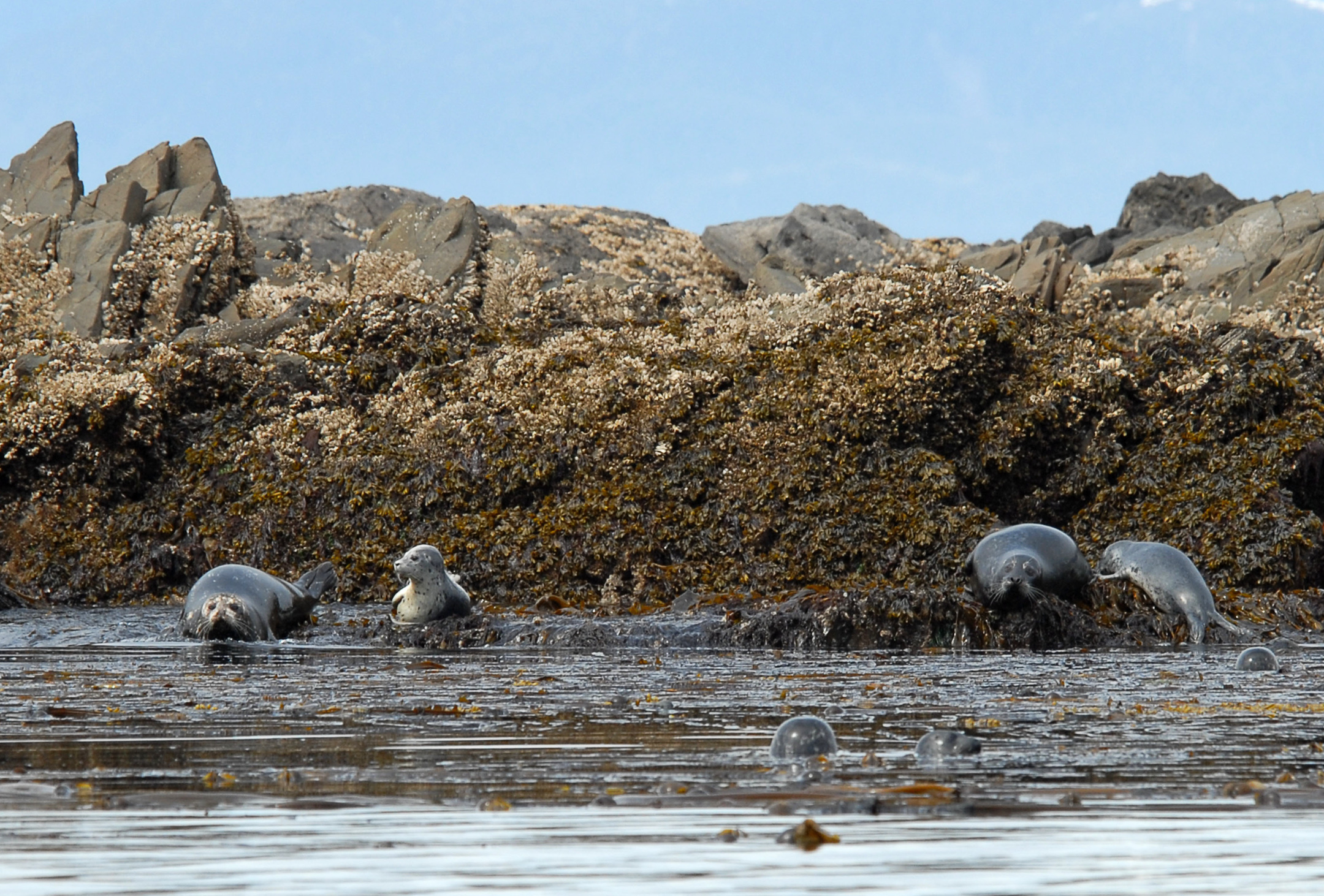Reproduction
Haul-Out Sites
Phoca vitulina are gregarious- meeting in the same location
every season to breed. They gather on reefs, gravel beached sand
bars, and an array of other coastal habitats. Known as “haul-out”
sites, these gatherings all have one common theme- they are all land
based (Seal Conservation Society, 2011). Haul-out sites are
inhabited by scattered small groups of seals, instead of a single
collective entity (Boness et al., 2006). These areas provide numerous
benefits for the seals including protection from predators and rough
environmental conditions; they also put P. vitulina in
close proximity to food sources. P. vitulina cling to these
safe havens during reproductive seasons deriving their name: the
harbor seal (Seal Conservation Society, 2011).
coastal habitats. Known as “haul-out”
sites, these gatherings all have one common theme- they are all land
based (Seal Conservation Society, 2011). Haul-out sites are
inhabited by scattered small groups of seals, instead of a single
collective entity (Boness et al., 2006). These areas provide numerous
benefits for the seals including protection from predators and rough
environmental conditions; they also put P. vitulina in
close proximity to food sources. P. vitulina cling to these
safe havens during reproductive seasons deriving their name: the
harbor seal (Seal Conservation Society, 2011).
Harbor seals at a moss covered haul out site. Photo credit: Dave
Withrow
Premating Season
During the premating season- before females enter estrus (heat) and
prior to pupping season- males decrease their foraging efforts,
their primary offshore activity, while increasing the time spent
competing for females on the shore (Boness et al., 2006). This coincides with rising
evidence that Phoca vitulina have a lek based reproductive
system- a system in which females choose the males while males,
attempt to, impress possible mates (Boness et al., 2006). Some premating tactics include
visual displays, vocalizations (under- and above- water), and even
fighting against other males in order to impress females (Boness et
al., 2006).
Mating Season
During the mating season- when females are in estrus (following
pupping season) - the tactics change. Males increase their
underwater vocalizations, which are now believed to be a part of
their mating behavior (SeaWorld, 2005). This idea arises from the fact that male
harbor seals vocalize more often when females are likely to be
present. Males also chase, bite the neck and flipper of (a playful
activity), and embrace the females more (SeaWorld, 2005). Even
though they compete for females on land, they mate nearby in the
shallow waters (in order to reduce possible predation that arises in
deeper waters) (Boness et al., 2006). The male is not limited to one
female per season though, as males will mate with several females
per year. Multiple births are extremely rare (never more than two),
limiting the mothers to one pup annually (SeaWorld, 2005). This
could be one of the factors into why some populations of harbor
seals are declining, such as the colony surrounding Britain (Seal
Conservation Society, 2011).
Pup Development
Giving birth at the haul-out site, the pups come into the world with
most of the abilities that an adult is capable of. Since Phoca
vitulina belongs to class
 Mammalia, the young will acquire
necessary nutrients from the mother’s milk. Her milk is primarily
fat- giving rise to the immense weight gain pups undergo before
weaning (occurring about six weeks after birth) (SeaWorld, 2005). They nurse both on
land and in water, requiring a constant source of nourishment every
three to four hours. The pups are very social animals when
they are young, but as the pup ages they become more and more
isolated (SeaWorld, 2005).
Mammalia, the young will acquire
necessary nutrients from the mother’s milk. Her milk is primarily
fat- giving rise to the immense weight gain pups undergo before
weaning (occurring about six weeks after birth) (SeaWorld, 2005). They nurse both on
land and in water, requiring a constant source of nourishment every
three to four hours. The pups are very social animals when
they are young, but as the pup ages they become more and more
isolated (SeaWorld, 2005).
Photo Credit: Robin Riggs, © Aquarium of the Pacific

 Photo Credit: Robin Riggs, © Aquarium of the
Pacific
Photo Credit: Hugh Ryono, © Aquarium of the Pacific
Photo Credit: Robin Riggs, © Aquarium of the
Pacific
Photo Credit: Hugh Ryono, © Aquarium of the Pacific
